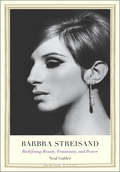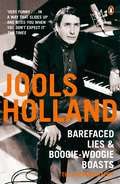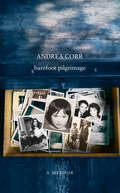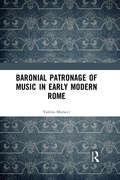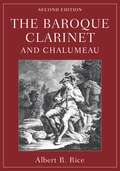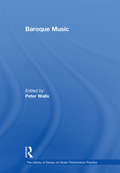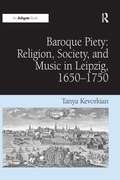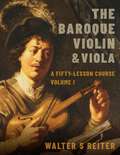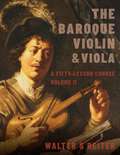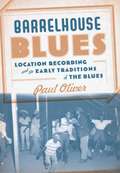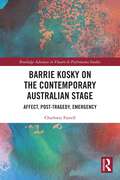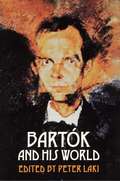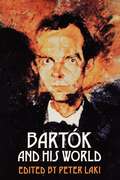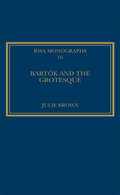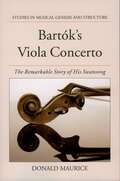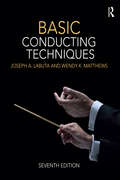- Table View
- List View
Barbra Streisand: Redefining Beauty, Femininity, and Power (Jewish Lives)
by Neal GablerBarbra Streisand has been called the “most successful...talented performer of her generation” by Vanity Fair, and her voice, said pianist Glenn Gould, is “one of the natural wonders of the age.” Streisand scaled the heights of entertainment—from a popular vocalist to a first-rank Broadway star in Funny Girl to an Oscar-winning actress to a producer and director. But she has also become a cultural icon who has transcended show business. To achieve her success, Brooklyn-born Streisand had to overcome tremendous odds, not the least of which was her Jewishness. Dismissed, insulted, even reviled when she embarked on a show business career for acting too Jewish and looking too Jewish, she brilliantly converted her Jewishness into a metaphor for outsiderness that would eventually make her the avenger for anyone who felt marginalized and powerless. Neal Gabler examines Streisand’s life and career through this prism of otherness—a Jew in a gentile world, a self-proclaimed homely girl in a world of glamour, a kooky girl in a world of convention—and shows how central it was to Streisand’s triumph as one of the voices of her age.
Barefaced Lies and Boogie-Woogie Boasts
by Harriet Vyner Jools HollandJools Holland has had a fascinating life. From playing on bomb sites as a boy in the East End, to skiving off school and then selling millions of records with Squeeze, the first twenty years of his life were eventful, chaotic and colourful. Then came The Tube with Paula Yates, the seminal live music programme that propelled him to fame. Over the following three decades, Jools succeeded in placing himself at the epicentre of a global community comprising just about anybody who is anybody in music. Through Later with Jools Holland, the longest-running music programme on television, he has given British TV debuts to countless now world famous bands. Packed with hilarious anecdotes written in Holland’s own inimitable style and laced with quirky insights and deliciously acute detail, this autobiography by one of Britain’s most gifted and debonaire musicians is not just for music fans, but for anyone who is looking for something several cuts above the conventional showbiz memoir.
Barefoot Pilgrimage
by Andrea CorrAndrea Corr’s Barefoot Pilgrimage is a compelling and honest memoir.
Baronial Patronage of Music in Early Modern Rome
by Valerio MorucciThis is the first dedicated study of the musical patronage of Roman baronial families in the sixteenth and early seventeenth centuries. Patronage – the support of a person or institution and their work by a patron – in Renaissance society was the basis of a complex network of familial and political relationships between clients and patrons, whose ideas, values, and norms of behavior were shared with the collective. Bringing to light new archival documentation, this book examines the intricate network of patronage interrelationships in Rome. Unlike other Italian cities where political control was monocentric and exercised by single rulers, sources of patronage in Rome comprised a multiplicity of courts and potential patrons, which included the pope, high prelates, nobles and foreign diplomats. Morucci uses archival records, and the correspondence of the Orsini and Colonna families in particular, to investigate the local activity and circulation of musicians and the cultivation of music within the broader civic network of Roman aristocratic families over the period. The author also shows that the familial union of the Medici and Orsini families established a bidirectional network for artistic exchange outside of the Eternal City, and that the Orsini-Colonna circle represented a musical bridge between Naples, Rome, and Florence.
Baronial Patronage of Music in Early Modern Rome
by Valerio MorucciThis is the first dedicated study of the musical patronage of Roman baronial families in the sixteenth and early seventeenth centuries. Patronage – the support of a person or institution and their work by a patron – in Renaissance society was the basis of a complex network of familial and political relationships between clients and patrons, whose ideas, values, and norms of behavior were shared with the collective. Bringing to light new archival documentation, this book examines the intricate network of patronage interrelationships in Rome. Unlike other Italian cities where political control was monocentric and exercised by single rulers, sources of patronage in Rome comprised a multiplicity of courts and potential patrons, which included the pope, high prelates, nobles and foreign diplomats. Morucci uses archival records, and the correspondence of the Orsini and Colonna families in particular, to investigate the local activity and circulation of musicians and the cultivation of music within the broader civic network of Roman aristocratic families over the period. The author also shows that the familial union of the Medici and Orsini families established a bidirectional network for artistic exchange outside of the Eternal City, and that the Orsini-Colonna circle represented a musical bridge between Naples, Rome, and Florence.
The Baroque Clarinet and Chalumeau
by Albert R. RiceThe first edition of Albert R. Rice's The Baroque Clarinet is widely considered the authoritative text on the European clarinet during the first half of the eighteenth century. Since its publication in 1992, its conclusions have influenced the approaches of musicologists, instrument historians, and clarinet performers. Twenty-eight years later, Rice has updated his renowned study in a second edition, with new chapters on chalumeau and clarinet music, insights on newly found instruments and additional material on the Baroque clarinet in society. Expanding the volume to include the chalumeau, close cousin and predecessor to the clarinet, Rice draws on nearly three decades of new research on the instrument's origins and music. Discoveries include two recently found chalumeaux in a private collection, one by Johann Heinrich Eichentopf of Leipzig, and attributions based on historical evidence for three more chalumeaux. Rice furthers the discussion to recently uncovered early instruments and historical scores, which shed light on the clarinet's evolution. Most essentially, Rice highlights the chalumeau's substantial late-seventeenth and early-eighteenth century repertory, comprising over 330 works by 66 composers, and includes a more expansive list of surviving Baroque clarinet works, organized by date, composer, and tonality/range. The Baroque Clarinet and Chalumeau provides a long-awaited follow-up to Rice's groundbreaking volume, drawing from a variety of sources-including German, Italian, Dutch, Swedish, Norwegian, Danish, Finnish, Flemish, Czech, and Catalan research-to bring this new information to an English-speaking audience. With his dedication to scholarly accuracy, Rice brings the Baroque clarinet into sharper focus than ever before.
BAROQUE CLARINET & CHALUMEAU 2E C
by Albert R. RiceThe first edition of Albert R. Rice's The Baroque Clarinet is widely considered the authoritative text on the European clarinet during the first half of the eighteenth century. Since its publication in 1992, its conclusions have influenced the approaches of musicologists, instrument historians, and clarinet performers. Twenty-eight years later, Rice has updated his renowned study in a second edition, with new chapters on chalumeau and clarinet music, insights on newly found instruments and additional material on the Baroque clarinet in society. Expanding the volume to include the chalumeau, close cousin and predecessor to the clarinet, Rice draws on nearly three decades of new research on the instrument's origins and music. Discoveries include two recently found chalumeaux in a private collection, one by Johann Heinrich Eichentopf of Leipzig, and attributions based on historical evidence for three more chalumeaux. Rice furthers the discussion to recently uncovered early instruments and historical scores, which shed light on the clarinet's evolution. Most essentially, Rice highlights the chalumeau's substantial late-seventeenth and early-eighteenth century repertory, comprising over 330 works by 66 composers, and includes a more expansive list of surviving Baroque clarinet works, organized by date, composer, and tonality/range. The Baroque Clarinet and Chalumeau provides a long-awaited follow-up to Rice's groundbreaking volume, drawing from a variety of sources-including German, Italian, Dutch, Swedish, Norwegian, Danish, Finnish, Flemish, Czech, and Catalan research-to bring this new information to an English-speaking audience. With his dedication to scholarly accuracy, Rice brings the Baroque clarinet into sharper focus than ever before.
Baroque Music
by Peter WallsResearch in the 20th and 21st centuries into historical performance practice has changed not just the way performers approach music of the 17th and 18th centuries but, eventually, the way audiences listen to it. This volume, beginning with a 1915 Saint-Sa lecture on the performance of old music, sets out to capture musicological discussion that has actually changed the way Baroque music can sound. The articles deal with historical instruments, pitch, tuning, temperament, the nexus between technique and style, vibrato, the performance implications of musical scores, and some of the vexed questions relating to rhythmic alteration. It closes with a section on the musicological challenges to the ideology of the early music movement mounted (principally) in the 1990s. Leading writers on historical performance practice are represented. Recognizing that significant developments in historically-inspired performance have been led by instrument makers and performers, the volume also contains representative essays by key practitioners.
Baroque Music
by Peter WallsResearch in the 20th and 21st centuries into historical performance practice has changed not just the way performers approach music of the 17th and 18th centuries but, eventually, the way audiences listen to it. This volume, beginning with a 1915 Saint-Sa lecture on the performance of old music, sets out to capture musicological discussion that has actually changed the way Baroque music can sound. The articles deal with historical instruments, pitch, tuning, temperament, the nexus between technique and style, vibrato, the performance implications of musical scores, and some of the vexed questions relating to rhythmic alteration. It closes with a section on the musicological challenges to the ideology of the early music movement mounted (principally) in the 1990s. Leading writers on historical performance practice are represented. Recognizing that significant developments in historically-inspired performance have been led by instrument makers and performers, the volume also contains representative essays by key practitioners.
Baroque Piety: Religion, Society, and Music in Leipzig, 1650-1750
by Tanya KevorkianDrawing upon a rich array of sources from archives in Leipzig, Dresden and Halle, Tanya Kevorkian illuminates culture in Leipzig before and during J.S. Bach's time in the city. Working with these sources, she has been able to reconstruct the contexts of Baroque and Pietist cultures at key periods in their development much more specifically than has been done previously. Kevorkian shows that high Baroque culture emerged through a combination of traditional frameworks and practices, and an infusion of change that set in after 1680. Among other forms of change, new secular arenas appeared, influencing church music and provoking reactions from Pietists, who developed alternative meeting, networking and liturgical styles. The book focuses on the everyday practices and active roles of audiences in public religious life. It examines music performance and reception from the perspectives of both 'ordinary' people and elites. Church services are studied in detail, providing a broad sense of how people behaved and listened to the music. Kevorkian also reconstructs the world of patronage and power of city councillors and clerics as they interacted with other Leipzig inhabitants, thereby illuminating the working environment of J.S. Bach, Telemann and other musicians. In addition, Kevorkian reconstructs the social history of Pietists in Leipzig from 1688 to the 1730s.
Baroque Piety: Religion, Society, and Music in Leipzig, 1650-1750
by Tanya KevorkianDrawing upon a rich array of sources from archives in Leipzig, Dresden and Halle, Tanya Kevorkian illuminates culture in Leipzig before and during J.S. Bach's time in the city. Working with these sources, she has been able to reconstruct the contexts of Baroque and Pietist cultures at key periods in their development much more specifically than has been done previously. Kevorkian shows that high Baroque culture emerged through a combination of traditional frameworks and practices, and an infusion of change that set in after 1680. Among other forms of change, new secular arenas appeared, influencing church music and provoking reactions from Pietists, who developed alternative meeting, networking and liturgical styles. The book focuses on the everyday practices and active roles of audiences in public religious life. It examines music performance and reception from the perspectives of both 'ordinary' people and elites. Church services are studied in detail, providing a broad sense of how people behaved and listened to the music. Kevorkian also reconstructs the world of patronage and power of city councillors and clerics as they interacted with other Leipzig inhabitants, thereby illuminating the working environment of J.S. Bach, Telemann and other musicians. In addition, Kevorkian reconstructs the social history of Pietists in Leipzig from 1688 to the 1730s.
The Baroque Violin & Viola: A Fifty-Lesson Course Volume I
by Walter S. ReiterIn the early seventeenth century, enthusiasm for the violin swept across Europe--this was an instrument capable of bewitching virtuosity, with the power to express emotions in a way only before achieved with the human voice. With this new guide to the Baroque violin, and its close cousin, the Baroque viola, distinguished performer and pedagogue Walter Reiter puts this power into the hands of today's players. Through fifty lessons based on the Reiter's own highly-renowned course at The Royal Conservatory of the Hague, The Baroque Violin & Viola, Volume I provides a comprehensive exploration of the period's rich and varied repertoire. Volume I covers the basics of choosing a violin, techniques to produce an ideal sound, and sonatas by Vivaldi and Corelli. Practical exercises are integrated into each lesson, and accompanied by rich video demonstrations on the book's companion website. Brought to life by Reiter's deep insight into key repertoire based on a lifetime of playing and teaching, The Baroque Violin & Viola, Volume I: A Fifty-Lesson Course will enhance performances of professional and amateur musicians alike.
BAROQUE VIOLIN & VIOLA, V2 C: A Fifty-Lesson Course
by Walter S. ReiterIn the early seventeenth century, enthusiasm for the violin swept across Europe--this was an instrument capable of bewitching virtuosity, with the power to express emotions in a way only before achieved with the human voice. With this new guide to the Baroque violin, and its close cousin, the Baroque viola, distinguished performer and pedagogue Walter Reiter puts this power into the hands of today's players. Through fifty lessons based on the Reiter's own highly-renowned course at The Royal Conservatory of the Hague, The Baroque Violin & Viola, Volume II provides a comprehensive exploration of the period's rich and varied repertoire. The lessons in Volume II cover the early seventeenth-century Italian sonata, music of the French Baroque, the Galant style, and the sonatas of composers like Schmelzer, Biber, and Bach. Practical exercises are integrated into each lesson, and accompanied by rich video demonstrations on the book's companion website. Brought to life by Reiter's deep insight into key repertoire based on a lifetime of playing and teaching, The Baroque Violin & Viola, Volume II: A Fifty-Lesson Course will enhance performances of professional and amateur musicians alike.
The Baroque Violin & Viola, vol. II: A Fifty-Lesson Course
by Walter S. ReiterIn the early seventeenth century, enthusiasm for the violin swept across Europe--this was an instrument capable of bewitching virtuosity, with the power to express emotions in a way only before achieved with the human voice. With this new guide to the Baroque violin, and its close cousin, the Baroque viola, distinguished performer and pedagogue Walter Reiter puts this power into the hands of today's players. Through fifty lessons based on the Reiter's own highly-renowned course at The Royal Conservatory of the Hague, The Baroque Violin & Viola, Volume II provides a comprehensive exploration of the period's rich and varied repertoire. The lessons in Volume II cover the early seventeenth-century Italian sonata, music of the French Baroque, the Galant style, and the sonatas of composers like Schmelzer, Biber, and Bach. Practical exercises are integrated into each lesson, and accompanied by rich video demonstrations on the book's companion website. Brought to life by Reiter's deep insight into key repertoire based on a lifetime of playing and teaching, The Baroque Violin & Viola, Volume II: A Fifty-Lesson Course will enhance performances of professional and amateur musicians alike.
BAROQUE VIOLIN & VIOLA C: A Fifty-Lesson Course Volume I
by Walter S. ReiterIn the early seventeenth century, enthusiasm for the violin swept across Europe--this was an instrument capable of bewitching virtuosity, with the power to express emotions in a way only before achieved with the human voice. With this new guide to the Baroque violin, and its close cousin, the Baroque viola, distinguished performer and pedagogue Walter Reiter puts this power into the hands of today's players. Through fifty lessons based on the Reiter's own highly-renowned course at The Royal Conservatory of the Hague, The Baroque Violin & Viola, Volume I provides a comprehensive exploration of the period's rich and varied repertoire. Volume I covers the basics of choosing a violin, techniques to produce an ideal sound, and sonatas by Vivaldi and Corelli. Practical exercises are integrated into each lesson, and accompanied by rich video demonstrations on the book's companion website. Brought to life by Reiter's deep insight into key repertoire based on a lifetime of playing and teaching, The Baroque Violin & Viola, Volume I: A Fifty-Lesson Course will enhance performances of professional and amateur musicians alike.
Barrelhouse Blues: Location Recording and the Early Traditions of the Blues
by Paul OliverIn the 1920s, Southern record companies ventured to cities like Dallas, Atlanta, and New Orleans, where they set up primitive recording equipment in makeshift studios. They brought in street singers, medicine show performers, pianists from the juke joints and barrelhouses. The music that circulated through Southern work camps, prison farms, and vaudeville shows would be lost to us if it hadn't been captured on location by these performers and recorders.Eminent blues historian Paul Oliver uncovers these folk traditions and the circumstances under which they were recorded, rescuing the forefathers of the blues who were lost before they even had a chance to be heard. A careful excavation of the earliest recordings of the blues by one of its foremost experts, Barrelhouse Blues expands our definition of that most American style of music.
Barrie Kosky on the Contemporary Australian Stage: Affect, Post-Tragedy, Emergency (Routledge Advances in Theatre & Performance Studies)
by Charlotte FarrellThis is the first book-length study of Australian theatre productions by internationally-renowned director, Barrie Kosky. Now a prolific opera director in Europe, Barrie Kosky on the Contemporary Australian Stage accounts for the formative years of Kosky's career in Australia. This book provides in-depth engagements with select productions including The Dybbuk which Kosky directed with Gilgul theatre company in 1991, as well as King Lear (1998), The Lost Echo (2006), and Women of Troy (2008). Using affect theory as a prism through which these works are analysed, the book accounts for the director's particular engagement with – and radical departure from – classical tragedy in contemporary performance: what the book defines as Kosky's 'post-tragedies'. Theatre studies scholars and students, particularly those with interests in affect, contemporary performance, 'director's theatre', and tragedy, will benefit from Barrie Kosky on the Contemporary Australian Stage’s vivid engagement with Kosky's work: a director who has become a singular figure in opera and theatre of international critical acclaim.
Barrie Kosky on the Contemporary Australian Stage: Affect, Post-Tragedy, Emergency (Routledge Advances in Theatre & Performance Studies)
by Charlotte FarrellThis is the first book-length study of Australian theatre productions by internationally-renowned director, Barrie Kosky. Now a prolific opera director in Europe, Barrie Kosky on the Contemporary Australian Stage accounts for the formative years of Kosky's career in Australia. This book provides in-depth engagements with select productions including The Dybbuk which Kosky directed with Gilgul theatre company in 1991, as well as King Lear (1998), The Lost Echo (2006), and Women of Troy (2008). Using affect theory as a prism through which these works are analysed, the book accounts for the director's particular engagement with – and radical departure from – classical tragedy in contemporary performance: what the book defines as Kosky's 'post-tragedies'. Theatre studies scholars and students, particularly those with interests in affect, contemporary performance, 'director's theatre', and tragedy, will benefit from Barrie Kosky on the Contemporary Australian Stage’s vivid engagement with Kosky's work: a director who has become a singular figure in opera and theatre of international critical acclaim.
Bartók and His World (The Bard Music Festival #50)
by Peter LakiBéla Bartók, who died in New York fifty years ago this September, is one of the most frequently performed twentieth-century composers. He is also the subject of a rapidly growing critical and analytical literature. Bartók was born in Hungary and made his home there for all but his last five years, when he resided in the United States. As a result, many aspects of his life and work have been accessible only to readers of Hungarian. The main goal of this volume is to provide English-speaking audiences with new insights into the life and reception of this musician, especially in Hungary. Part I begins with an essay by Leon Botstein that places Bartók in a large historical and cultural context. László Somfai reports on the catalog of Bartók's works that is currently in progress. Peter Laki shows the extremes of the composer's reception in Hungary, while Tibor Tallián surveys the often mixed reviews from the American years. The essays of Carl Leafstedt and Vera Lampert deal with his librettists Béla Balázs and Melchior Lengyel respectively. David Schneider addresses the artistic relationship between Bartók and Stravinsky. Most of the letters and interviews in Part II concern Bartók's travels and emigration as they reflected on his personal life and artistic evolution. Part III presents early critical assessments of Bartók's work as well as literary and poetic responses to his music and personality.
Bartók and His World (PDF)
by Peter LakiBéla Bartók, who died in New York fifty years ago this September, is one of the most frequently performed twentieth-century composers. He is also the subject of a rapidly growing critical and analytical literature. Bartók was born in Hungary and made his home there for all but his last five years, when he resided in the United States. As a result, many aspects of his life and work have been accessible only to readers of Hungarian. The main goal of this volume is to provide English-speaking audiences with new insights into the life and reception of this musician, especially in Hungary. Part I begins with an essay by Leon Botstein that places Bartók in a large historical and cultural context. László Somfai reports on the catalog of Bartók's works that is currently in progress. Peter Laki shows the extremes of the composer's reception in Hungary, while Tibor Tallián surveys the often mixed reviews from the American years. The essays of Carl Leafstedt and Vera Lampert deal with his librettists Béla Balázs and Melchior Lengyel respectively. David Schneider addresses the artistic relationship between Bartók and Stravinsky. Most of the letters and interviews in Part II concern Bartók's travels and emigration as they reflected on his personal life and artistic evolution. Part III presents early critical assessments of Bartók's work as well as literary and poetic responses to his music and personality.
Bartók and the Grotesque: Studies in Modernity, the Body and Contradiction in Music
by Julie BrownThe grotesque is one of art's most puzzling figures - transgressive, comprising an unresolveable hybrid, generally focussing on the human body, full of hyperbole, and ultimately semantically deeply puzzling. In Bluebeard's Castle (1911), The Wooden Prince (1916/17), The Miraculous Mandarin (1919/24, rev. 1931) and Cantata Profana (1930), Bart ngaged scenarios featuring either overtly grotesque bodies or closely related transformations and violations of the body. In a number of instrumental works he also overtly engaged grotesque satirical strategies, sometimes - as in Two Portraits: 'Ideal' and 'Grotesque' - indicating this in the title. In this book, Julie Brown argues that Bart concerns with stylistic hybridity (high-low, East-West, tonal-atonal-modal), the body, and the grotesque are inter-connected. While Bart eveloped each interest in highly individual ways, and did so separately to a considerable extent, the three concerns remained conceptually interlinked. All three were thoroughly implicated in cultural constructions of the Modern during the period in which Bart as composing.
Bartók and the Grotesque: Studies in Modernity, the Body and Contradiction in Music
by Julie BrownThe grotesque is one of art's most puzzling figures - transgressive, comprising an unresolveable hybrid, generally focussing on the human body, full of hyperbole, and ultimately semantically deeply puzzling. In Bluebeard's Castle (1911), The Wooden Prince (1916/17), The Miraculous Mandarin (1919/24, rev. 1931) and Cantata Profana (1930), Bart ngaged scenarios featuring either overtly grotesque bodies or closely related transformations and violations of the body. In a number of instrumental works he also overtly engaged grotesque satirical strategies, sometimes - as in Two Portraits: 'Ideal' and 'Grotesque' - indicating this in the title. In this book, Julie Brown argues that Bart concerns with stylistic hybridity (high-low, East-West, tonal-atonal-modal), the body, and the grotesque are inter-connected. While Bart eveloped each interest in highly individual ways, and did so separately to a considerable extent, the three concerns remained conceptually interlinked. All three were thoroughly implicated in cultural constructions of the Modern during the period in which Bart as composing.
Bartok's Viola Concerto: The Remarkable Story of His Swansong (Studies In Musical Genesis, Structure, and Interpretation)
by Donald MauriceWhen Bela Bartók died in September of 1945, he left a partially completed viola concerto commissioned by the virtuoso violist William Primrose. Yet, while no definitive version of the work exists, this concerto has become arguably the most-performed viola concerto in the world. The story of how the concerto came to be, from its commissioning by Primrose to its first performance to the several completions that are performed today is told here in Bartók's Viola Concerto:The Remarkable Story of His Swansong. After Bartók's death, his family asked the composer's friend Tibor Serly to look over the sketches of the concerto and to prepare it for publication. While a draft was ready, it took Serly years to assemble the sketches into a complete piece. In 1949, Primrose finally unveiled it, at a premiere performance with the Minneapolis Symphony Orchestra. For almost half a century, the Serly version enjoyed great popularity among the viola community, even while it faced charges of inauthenticity. In the 1990s, several revisions appeared and, in 1995, the composer's son, Peter Bartók, released a revision, opening the way or an intensified debate on the authenticity of the multiple versions. This debate continues as violists and Bartók scholars seek the definitive version of this final work of Hungary's greatest composer. Bartók's Viola Concerto tells the story of the genesis and completion of Bartók's viola concerto, its reception over the second half of the twentieth century, its revisions, and future possibilities.
Basic Conducting Techniques
by Joseph A. Labuta Wendy K. MatthewsBasic Conducting Techniques, Seventh Edition, provides a clear and intelligible introduction to the art of conducting an ensemble. Over the course of fourteen chapters, the authors explicate the elements of conducting, supplementing their teachings with an extensive selection of musical examples from the classical repertoire. Practical and innovative, clear and approachable, this text illuminates the essential skills a beginning conductor should develop to lead and rehearse a performing group. This new edition features: chapters rewritten to highlight important information and show connections between different sections a new chapter on expressive conducting, consisting of expanded and updated content select full scores in the "Musical Excerpts" section excerpts with transpositions for each chapter, allowing easy access for class performance a new companion website, which includes the scores and transpositions for all musical excerpts, audio recordings of the excerpts, and demonstration videos modeling specific techniques for each chapter. With the beginning conductor in mind, this hands-on, competency-centered approach is appropriate for mixed classes of choral and instrumental music majors, providing indispensable versatility for students and practicing conductors alike. Rooted in decades of teaching and conducting experience, Basic Conducting Techniques is the essential guide to the principles of conducting.
Basic Conducting Techniques
by Joseph A. Labuta Wendy K. MatthewsBasic Conducting Techniques, Seventh Edition, provides a clear and intelligible introduction to the art of conducting an ensemble. Over the course of fourteen chapters, the authors explicate the elements of conducting, supplementing their teachings with an extensive selection of musical examples from the classical repertoire. Practical and innovative, clear and approachable, this text illuminates the essential skills a beginning conductor should develop to lead and rehearse a performing group. This new edition features: chapters rewritten to highlight important information and show connections between different sections a new chapter on expressive conducting, consisting of expanded and updated content select full scores in the "Musical Excerpts" section excerpts with transpositions for each chapter, allowing easy access for class performance a new companion website, which includes the scores and transpositions for all musical excerpts, audio recordings of the excerpts, and demonstration videos modeling specific techniques for each chapter. With the beginning conductor in mind, this hands-on, competency-centered approach is appropriate for mixed classes of choral and instrumental music majors, providing indispensable versatility for students and practicing conductors alike. Rooted in decades of teaching and conducting experience, Basic Conducting Techniques is the essential guide to the principles of conducting.
